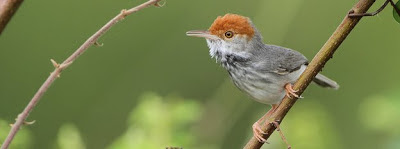Jakarta Globe, JG/AFP, June 27, 2013
 |
| Haze hangs over a river in Siak, Riau Province, Indonesia on Wednesday, June 26, 2013 (Bloomberg Photo/Dimas Ardian) |
Heavy rains
continued to fall on the fires still smoldering on the Indonesian island of
Sumatra on Thursday as Malaysian officials pushed Indonesia to ratify a
long-ignored treaty banning hazardous slash-and-burn clearing for plantations.
Malaysian
Environment Minister G. Palanivel visited his Indonesian counterpart on
Thursday after nine days of widespread plantation fires in Riau left the region
choking on some of the worst levels of air pollution in more than a decade. The
minister urged Indonesia to get serious about tackling what has become an
annual problem.
The
Association of Southeast Asian Nations (Asean) issued a treaty in 2002 after a
similar crisis in 1997 cost the region an estimated $9 billion in losses.
Indonesia, which was responsible for the 1997 haze crisis, has refused to
ratify the treaty.
“The
environment minister has to deal with this ratification,” Palanivel told the
Agence France-Presse. “If they can ratify the treaty then they can go forward.”
Indonesian
Environment Minister Balthasar Kambuaya said the nation was “in the process” of
ratifying the treaty.
Thursday’s
meeting came as the dangerous haze covering Malaysia and Singapore continued to
dissipate after days of favorable winds and heavy rains. The number of hotspots
reported in Sumatra fell to 59 on Thursday, down from 264 record at the height
of the blaze, the Pekanbaru chapter of the Meteorology, Geophysics and Climate
Agency said.
Thousands
of fire fighters doused the remaining fires on Thursday as local police
arrested five more farmers allegedly responsible for the initial fires that
sparked the massive blaze. Riau Police have detained 14 people in their
widening investigation into this year’s plantation fires as officers looked
into allegations that four plantation companies were involved in illegal land
clearing.
“The
suspects are still being questioned and are under police investigation,” Riau
Police spokesman Adj. Comr. Hermansyagh said of the farmers.
The farmers
reportedly lost control of fire set to clear their lands, Hermansyagh said.
This year’s
forest fires ignited a diplomatic row between Singapore, Indonesia and Malaysia
and prompted President Susilo Bambang Yudhoyono to issue a formal apology to
Indonesia’s neighbors over the haze. But as the situation returned to normal on
Thursday, the Indonesian Agency for the Assessment and Application of
Technology (BPPT) warned that the dry season — and the annual forest fires it
brings — had only just begun.
“We will
have a dry season until October,” Heru Widodo, head of the artificial rain unit
at the BPPT. “So it’s possible that the number of hotspots will increase
again.”
















